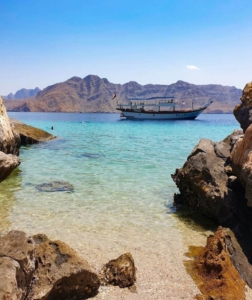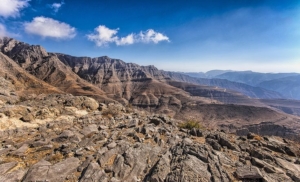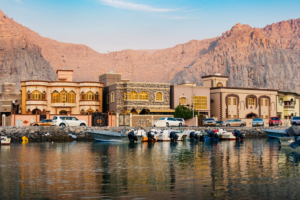

Khasab Oman Map: A Local’s Guide to Hidden Treasures
Welcome to Khasab, the “Norway of Arabia” – a magical place where rugged fjords blend into desert mountains. Being a local who knows every hidden path in this captivating region, I’ve put together a detailed Khasab Oman map guide to help you explore our unique terrain.
Our coastal capital of Musandam Governorate houses 21,651 people. We’re tucked away among the stunning peaks of the Western Hajar Range. This prime location makes Khasab a favorite weekend escape for UAE residents who can reach us through the scenic coastal road. Let me show you the real Khasab that goes far beyond tourist attractions. You’ll experience everything from our record-breaking 1.8 km overwater zip-line to peaceful beaches and time-forgotten mountain villages.
Understanding Khasab’s Geography
Khasab sits proudly at 26°11′N 56°15′E, marking the northernmost point of the Musandam Peninsula. Our city’s strategic position creates a crucial intersection of shipping routes that connect the Arabian Gulf with the Arabian Sea.
Location and key regions
The Musandam Governorate, an Omani exclave, borders the UAE and watches over the Strait of Hormuz. The region’s geology tells a fascinating story. The Arabian plate’s slow movement beneath the Eurasian plate has altered the map. This tectonic activity created our region’s most remarkable feature – seawater-filled sunken valleys that formed our famous fjords.
Khasab’s surroundings offer striking contrasts. The Western Hajar mountains create a rugged backdrop, while our coastline features deep, strait-like bays that offer natural protection. Our city’s fertile soil supports thriving agriculture, creating vibrant green patches amid the rocky terrain.
Major landmarks for orientation
Visitors using the Khasab map will find these landmarks helpful to navigate:
- Khasab Fort: This 17th-century structure stands at our city’s heart, serving as both a historical monument and a central reference point
- Musandam Fjords: These natural wonders line our coast and define our region’s character
- Jebel Harim: At 2,087 meters, this peak towers as Musandam’s highest point, offering spectacular views across the peninsula
- Khasab Seaport: Our bustling harbor, known for its traditional dhows, launches countless maritime adventures
The Khasab Coastal Road naturally connects to the UAE’s E11 Highway. This easy access has turned our once-remote town into a lively center for visitors and traders. Our region stands as the only place in Oman where mountains meet fjords, creating scenery that fascinates everyone who visits.

Essential Routes Through Khasab
The routes around Khasab blend beautiful coastal drives with mountain adventures. Let me show you the best paths that highlight our region’s amazing landscape.
Coastal road navigation
Route 2, now called the Khasab Coastal Road, connects us to the outside world. This beautiful highway runs 44 kilometers from Khasab to Tibat. You’ll see stunning sea views on one side and tall rock walls on the other. The trip takes about 45 minutes, but you should take extra time to stop at beach spots with palm thatch sunshades, especially near Al Jadi village.
The new Khasab-Lima-Dibba motorway project is changing how we get around, and it’s 26% complete. This road will cut down travel time a lot – you’ll be able to drive from Khasab to Lima in just 22 minutes.
Mountain paths and viewpoints
Mountain lovers will enjoy the Khor Najd ridgeline trail that starts at the ‘I love Oman’ sign. The path heads over to amazing viewpoints above Khor Najd that are better than what you’ll see from the road below. Jebel Harim stands as our highest point at 2,087 meters. Tours usually stop at 1,600 meters because there’s a military radar station at the top.
Harbor area layout
Khasab’s port sits in a perfect spot facing the Strait of Hormuz. Our harbor has:
- A protected 10-meter deep basin
- Three berths measuring 60m, 90m, and 300m
- 22 hectares of open yards
- 4,000 square meters of covered storage
Cruise ships, ferries, and Iranian freight keep our port busy as a key maritime hub. Visitors can hop on free shuttle busses from the cruise terminal to the city center, where local tour companies offer great deals on excursions.

Hidden Gems Off Tourist Maps
The hidden treasures of Khasab lie beyond its popular tourist spots. I’ve spent years learning about these lesser-known corners and want to share some of our best-kept secrets with you.
Local fishing spots
Khasab’s waters are rich with marine life. You’ll find kingfish, snapper, grouper, and barracuda in abundance. The dramatic coastline, where towering cliffs meet crystal-clear waters, holds our most productive fishing grounds. Local experts know exclusive spots in the deeper waters of the Musandam fjords that yield the best catches.
These pristine waters are great for both guided and independent fishing adventures. The calm conditions make it perfect for beginners, and local guides love to share their knowledge about seasonal fish movements and effective techniques.
Secret beaches
Secret Beach is one of our most treasured hidden gems where you can escape the tourist crowds. This quiet paradise has soft sands and shimmering turquoise waters. Stunning cliffs and lush greenery surround the area.
The beaches along the southern-west area have fine sand with small dunes that create a beautiful contrast against the peaks and cliffs. Khor Najd offers a peaceful beach experience facing the Gulf of Oman and you’ll need an SUV to reach it.
Mountain villages
The Musandam Peninsula’s interior rises sharply from the shore. It creates a maze of peaks and valleys where traditional villages sit in seemingly impossible positions. Small hamlets line the shoreline, and boats provide the only access to these communities where a few families live.
Sayah village sits at 914 meters elevation and is one of the most beautiful settlements in the peninsula. The area has pure springs, wadis, and green landscapes where locals continue their traditional work:
- Fishing and livestock rearing
- Date palm cultivation
- Lemon and vegetable farming
The wilayat has historic mosques that showcase the region’s rich heritage, like Al Seebah (rebuilt in 1980) and Al Souq. These mountain communities blend naturally into the harsh landscape with their traditional architecture. They show us a way of life that has lasted for generations.

Seasonal Navigation Tips
Khasab’s terrain needs different travel approaches as seasons change. The weather shapes how people choose their routes and when they travel in this unique region.
Summer route adjustments
Summer months (May to September) bring temperatures of 30°C to 40°C. You need to plan your trips carefully. Early morning or late afternoon trips work best for outdoor activities. These tried-and-true guidelines will help you explore comfortably:
- Pack high-SPF sunscreen and head protection, especially in June, July, and August
- Start harbor activities before 10 AM
- Save mountain routes for late afternoon
- Keep extra water in your vehicle
Heat affects both land and sea travel in summer. Short trips work better than full-day excursions. Air-conditioned transport between stops makes sense whenever possible. Mountain paths get too hot for hiking in peak summer, so boat tours become a better choice.
Winter accessibility guide
The weather turns perfect between October and April with ideal conditions and temperatures of 20°C to 28°C. Winter changes Khasab’s landscape and makes it great for complete exploration. The Musandam Winter Season runs from November through April and brings many benefits to travelers.
Winter gives you better visibility and comfortable weather for coastal and mountain trips. The weather becomes pleasant right after October starts. This creates the best conditions for outdoor activities. More dhow cruises run during winter months as marine activity picks up.
Winter travel works best if you:
- Look up weather forecasts before mountain trips
- Think about shorter daylight hours while planning
- Bring light jackets for evening activities
- Watch for rain between December and March
Rain shows up in winter and makes mountain paths muddy and slippery. Some remote areas become hard to reach. Mountain regions should be avoided during rainy days unless absolutely needed.
The coastal road stays open all year, though morning fog can limit visibility in winter. Harbor areas buzz with activity as multiple dhow trips leave each day. Mountain villages become easier to reach thanks to mild temperatures and clear conditions.
Digital and Traditional Navigation Tools
Khasab’s navigation landscape blends modern technology with ancient wisdom. Visitors and residents use various tools from advanced GPS systems to local knowledge to find their way around our unique terrain.
Local apps and resources
You need reliable navigation tools to learn about Khasab’s remote areas. My first tip is to download offline maps because mobile signals can be weak in some areas. ViaMichelin is a detailed resource that shows you:
- Street names and road types
- Administrative buildings
- Local landmarks
- Up-to-the-minute traffic updates
- Parking locations
Besides regular navigation apps, Khasab has its own offline map navigator that works without any connection and saves you roaming costs. The app uses vector maps that get regular updates from OpenStreetMap. Street names appear in both local and English languages.
Traditional landmarks used by locals
The Omani Fjords help travelers find their way, with their unique shapes guiding people both at sea and on land. The Turtledove Rock has helped sailors navigate Musandam Peninsula’s waters throughout history.
Telegraph Island in the Musandam Peninsula is a vital landmark. The British built it as a telegraph line station between India and Europe, and its ruins now help travelers navigate.
GPS coordinates for remote spots
These GPS coordinates will help you find Khasab’s important places:
- City Center: 26°10’47″N 56°14’51″E
- Khasab Port: 26.2054°N, 56.2501°E
- Main City Area: 26°9’51.9768″N and 56°14’33.5076″E
The port has a protected 10-meter deep harbor basin with three berths that measure 60m, 90m, and 300m. These coordinates help sailors navigate easily.
Modern navigation apps offer 2D and 3D views and find the shortest and safest routes for people walking, cycling, or driving. All the same, you should know traditional navigation methods as a backup.
Digital tools and traditional landmarks work together to create a strong navigation system. This combined approach helps you safely explore our region’s remote areas and hidden spots. The port faces the Strait of Hormuz and serves as a key reference point, with 22 hectares of open yards and 4,000 square meters of covered sheds that stand out.
GPS tracking helps travelers in mountainous areas where regular phone signals might not work well. Our region sits at 26.17993° latitude and 56.24774° longitude, which creates unique navigation challenges. That’s why using multiple navigation tools works best here.

Conclusion
Khasab is a remarkable blend of natural wonders and cultural heritage that truly deserves its “Norway of Arabia” nickname. I’ve watched countless visitors fall in love with our unique landscape as I spent years learning about these dramatic fjords and mountain paths.
Digital tools can help direct you around our region, but local knowledge is the best way to find Khasab’s treasures. Our coastal roads, mountain trails, and hidden beaches create adventures for every type of traveler. The summer months can be challenging, but winter brings perfect weather to learn about our fjords and ancient villages.
The best experiences in Khasab lie beyond the typical tourist spots. You’ll find secret beaches, mountain villages with centuries-old traditions, and local fishing spots that aren’t in standard travel guides. Each day here tells its own story, whether you’re climbing Jebel Harim’s heights or cruising through our crystal-clear waters.
The well-marked routes and hidden paths lead to unforgettable moments in this corner of Oman. Bring your sense of adventure, respect local customs, and let Khasab’s natural beauty and warm hospitality direct your way through our extraordinary homeland. Book Now!
